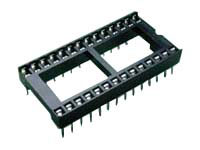marcos.placona
Senior Member
Hi guys, here's me again with two questions.
I think they should be pretty straight forward, but here we go.
First, I was checking some circuit samples here at the forum, and found this one to be pretty neat:

Well, my question is not really related to the circuit, as it's pretty straight forward, but I wanted to ask you about the pins being used. They make like so much easier, as as far as I understood, you can connect wires to them, the same way as you do on the breadboard, which would make my life easier when having to disconnect my board from my project, as I would just take off all the wires connected to the ping, make my modifications and put the wires back and they can also be connected to the bread board.
But I don't know how to refer to it, or how to look for it. Is there as special name for that? I tried socket strip, but no luck. Can anybody tell me what is the name of that?
The second question would be regarding a way to expand the I/O ports on the 08M. I found a way to do that by using a 74HC595, but my supplier doesn't have it, so I wanted to know of any similar IC I could use to do that.
Thanks in advance,
Marcos Placona
I think they should be pretty straight forward, but here we go.
First, I was checking some circuit samples here at the forum, and found this one to be pretty neat:

Well, my question is not really related to the circuit, as it's pretty straight forward, but I wanted to ask you about the pins being used. They make like so much easier, as as far as I understood, you can connect wires to them, the same way as you do on the breadboard, which would make my life easier when having to disconnect my board from my project, as I would just take off all the wires connected to the ping, make my modifications and put the wires back and they can also be connected to the bread board.
But I don't know how to refer to it, or how to look for it. Is there as special name for that? I tried socket strip, but no luck. Can anybody tell me what is the name of that?
The second question would be regarding a way to expand the I/O ports on the 08M. I found a way to do that by using a 74HC595, but my supplier doesn't have it, so I wanted to know of any similar IC I could use to do that.
Thanks in advance,
Marcos Placona





